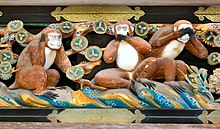Nikkō Tōshō-gū
| Nikkō Tōshō-gū 日光東照宮 | |
|---|---|
 Yōmeimon | |
| Width | 300 |
| Website | |
| http://www.toshogu.jp/ | |
Nikkō Tōshō-gū (日光東照宮) is a Shinto shrine located in Nikkō, Tochigi Prefecture, Japan. It is part of the "Shrines and Temples of Nikkō", a UNESCO World Heritage Site.
History
Tōshō-gū is dedicated to Tokugawa Ieyasu, the founder of the Tokugawa shogunate. Initially built in 1617, during the Edo period, while Ieyasu's son Hidetada was shogun, it was enlarged during the time of the third shogun, Iemitsu. Ieyasu is enshrined there, where his remains are also entombed. This shrine is built by Tokugawa retainer Tōdō Takatora.
During the Edo period, the Tokugawa shogunate carried out stately processions from Edo to the Nikkō Tōshō-gū along the Nikkō Kaidō. The shrine's annual spring and autumn festivals reenact these occasions, and are known as "processions of a thousand warriors." Also part of the beauty is the row of majestic trees lining the roadway, termed the Cedar Avenue of Nikkō.
Five structures at Nikkō Tōshō-gū are categorized as National Treasures of Japan, and three more as Important Cultural Properties. Additionally, two swords in the possession of the shrine are National Treasures, and numerous other objects are Important Cultural Properties. Famous buildings at the Tōshō-gū include the richly decorated Yōmeimon, a gate that is also known as "higurashi-no-mon." The latter name means that one could look at it until sundown, and not tire of seeing it. Carvings in deep relief, painted in rich colors, decorate the surface of the structure. The next gate is the karamon decorated with white ornaments. Nearby, a carving of the sleepy cat, "Nemuri-neko", is attributed to Hidari Jingorō.


The stable of the shrine's sacred horses bears a carving of the three wise monkeys, who hear, speak and see no evil, a traditional symbol in Chinese and Japanese culture.
The original five-story pagoda was donated by a daimyo in 1650, but it was burned down during a fire, and was rebuilt in 1818. Each story represents an element - earth, water, fire, wind and aether or void - in ascending order. Inside the pagoda, a central shinbashira pillar hangs from chains[1] to minimize damage from earthquakes.[2]



Hundreds of stone steps lead through the cryptomeria forest up to the grave of Ieyasu. A torii at the top bears calligraphy attributed to Emperor Go-Mizunoo. A bronze urn contains the remains of Tokugawa Ieyasu.
In 2008 Yuri Kawasaki became the first female Shinto priest ever to serve at Nikkō Tōshō-gū.[3]
Gallery
-
Torii and pagoda at entrance to Tōshō-gū.
-
Tablet: Tōshō Dai-Gongen (東照大権現) on torii. Attributed to Emperor Go-Mizunoo.
-
Oranda dōrō (Dutch lantern) is gift from the Dutch East India Company (V.O.C.) presented to the shogun in 1643.
-
This bell is gift from the Joseon Dynasty.
-
Lavish decoration adjacent to Yomeimon.
-
Sake barrels.
-
Carvings above the Karamon.
-
Kagura-den, a hall for dances dedicated to gods in the divine work for Shintoism.
-
Sleeping Cat is a symbol of peace.
-
Urn containing remains of Tokugawa Ieyasu.
-
The Sacred Horse at Nikkō Tōshō-gū
-
An explanation tablet about Sacred Horses at Nikkō Tōshō-gū
See also
- List of National Treasures of Japan (shrines)
- List of National Treasures of Japan (crafts-swords)
- Shinbashira, the central wooden column, almost freely suspended
- Ueno Tōshō-gū
References and notes
- ^ Parent, Mary Neighbour (2003), "shinbashira", Japanese Architecture and Art Net Users System, retrieved 2009-03-28
- ^ Tanimura, Akihiko; Ishida, Shuzo (1997), "Energy dispersion and dissipation mechanism of a Shinbashira-Frame system", Journal of Structural Engineering B, 43B: 143–150, ISSN 0910-8033
- ^ 1st female Shinto priest named at Nikko Toshogu at Discover Seattle.net












